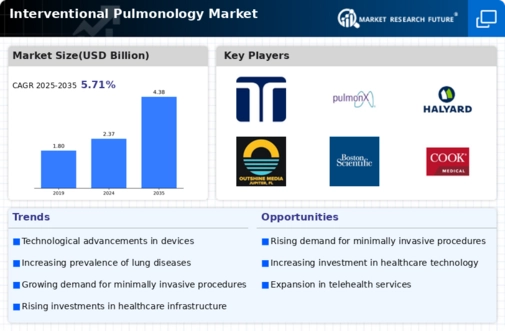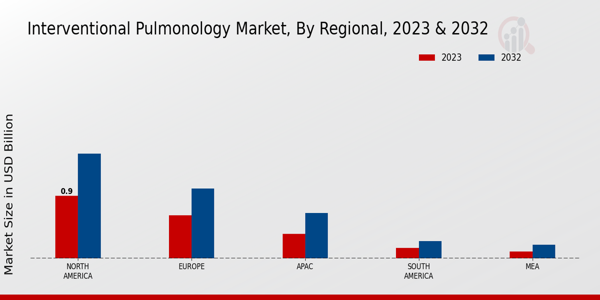Market Growth Projections
The Global Interventional Pulmonology Market Industry is projected to experience substantial growth in the coming years. With a market value of 2.37 USD Billion in 2024, it is expected to reach 4.38 USD Billion by 2035. This growth trajectory indicates a compound annual growth rate (CAGR) of 5.73% from 2025 to 2035. Such projections reflect the increasing demand for innovative interventional pulmonology solutions driven by factors such as rising respiratory disease prevalence, technological advancements, and growing healthcare expenditures. The market's expansion is indicative of the critical role interventional pulmonology plays in addressing global respiratory health challenges.
Growing Awareness and Education
Growing awareness and education regarding respiratory health are pivotal drivers of the Global Interventional Pulmonology Market Industry. Public health campaigns and educational initiatives aimed at both healthcare professionals and patients are fostering a better understanding of respiratory diseases and the importance of early intervention. This heightened awareness is likely to lead to increased patient referrals for interventional procedures, thereby expanding the market. As more individuals recognize the benefits of timely diagnosis and treatment, the demand for interventional pulmonology services is expected to rise, contributing to the overall growth of the industry.
Increasing Healthcare Expenditure
The Global Interventional Pulmonology Market Industry is benefiting from rising healthcare expenditures across various regions. Governments and private sectors are increasingly allocating funds to improve healthcare infrastructure and access to advanced medical technologies. This trend is particularly evident in emerging economies, where investments in healthcare are expanding rapidly. Enhanced funding allows for the acquisition of state-of-the-art interventional pulmonology equipment, thereby improving diagnostic and treatment capabilities. As healthcare spending continues to rise, the demand for interventional pulmonology services is expected to increase, further driving market growth.
Aging Population and Demographic Shifts
The aging population and demographic shifts are critical factors influencing the Global Interventional Pulmonology Market Industry. As the global population ages, the prevalence of age-related respiratory conditions is anticipated to increase. Older adults are more susceptible to respiratory diseases, necessitating advanced interventional pulmonology services. This demographic trend is likely to drive demand for specialized treatments and interventions tailored to the needs of older patients. Consequently, the market is poised for growth as healthcare systems adapt to cater to this demographic shift, ensuring that interventional pulmonology services are accessible and effective for an aging population.
Rising Prevalence of Respiratory Diseases
The Global Interventional Pulmonology Market Industry is experiencing growth driven by the increasing incidence of respiratory diseases such as chronic obstructive pulmonary disease (COPD) and lung cancer. According to health statistics, respiratory diseases account for a substantial portion of global morbidity and mortality. The demand for advanced diagnostic and therapeutic interventions is likely to rise as the population ages and environmental factors contribute to respiratory health issues. This trend is expected to propel the market, with projections indicating a market value of 2.37 USD Billion in 2024, highlighting the urgent need for innovative interventional pulmonology solutions.
Technological Advancements in Medical Devices
Technological innovations in medical devices are significantly influencing the Global Interventional Pulmonology Market Industry. The introduction of minimally invasive techniques and advanced imaging technologies has enhanced the efficacy of procedures such as bronchoscopy and endobronchial ultrasound. These advancements not only improve patient outcomes but also reduce recovery times, making them more appealing to healthcare providers. As a result, the market is projected to grow at a compound annual growth rate (CAGR) of 5.73% from 2025 to 2035, potentially reaching 4.38 USD Billion by 2035. This growth underscores the importance of continuous investment in research and development within the sector.












